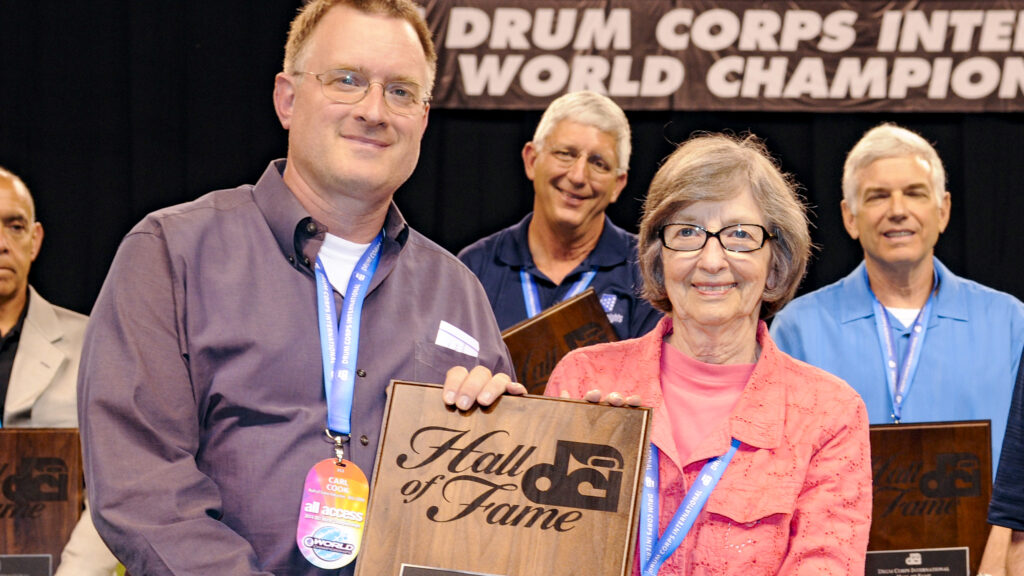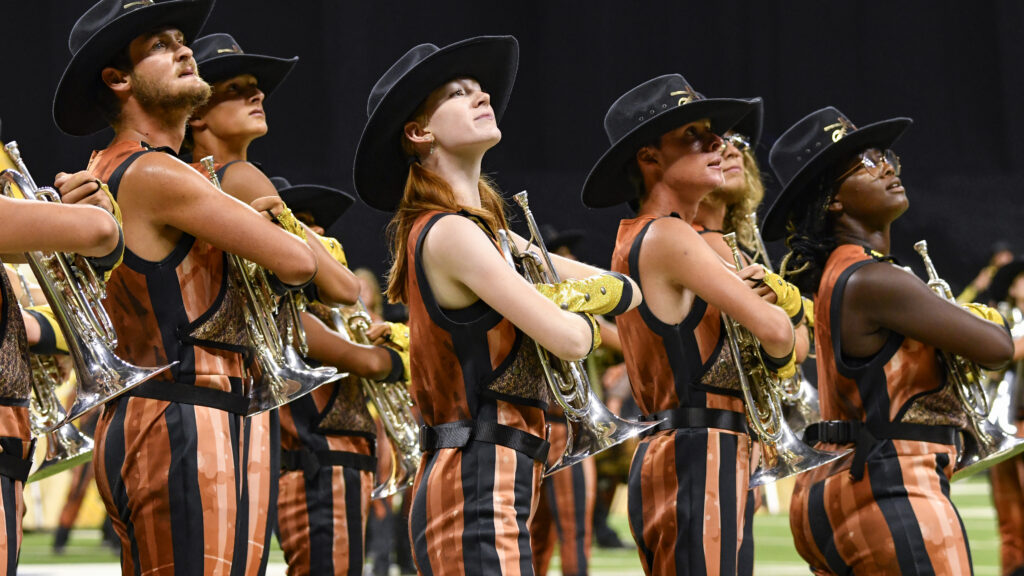Sandra Clark is passionate about French horns and especially the Blue Devils’ line, having marched in the corps from 1979 through 1981. Sandra has been coprincipal horn for the Toledo Symphony since 1990, and contributed the following article. For young drum corps aficionados, the French horn is an instrument one hears in band and orchestra, but not in drum corps (it has since been replaced by mellophones). But in the early days of DCI, the drum corps French horn was an integral part of every line until groups like the Cadets began their inexorable march to the top — without the “burden” of those quirky and unpredictable instruments. There was (to this performer) a visceral, unique and thrilling sound to a drum corps line that had a full-bodied French horn section. I had the great pleasure to be a member of one of the finest groups of players (in my honest opinion) to ever march. Though not all of us marched in the same years, there was a fantastic consistency that came from a strong tradition — one that I would have to say began with Scott Tiret. A true veteran of Blue Devils, he came up through the ranks from the very first years of DCI to be BD’s strongest French horn player. He was Bonnie Ott’s duet partner in “Chase the Clouds Away” in 1976 and, by his age-out year in 1979, the soloist in “La Suerta de los Tontos.” David Tuttle came to BD from Kansas in 1976. Years later I heard him at San Jose State as he discussed taking lessons with the professor. He mentioned that he’d never had a private lesson! He’s one of the few people in drum corps to sport four championship rings — 1976, 1977, 1979 and his age-out year of 1980. Dave has since gone on to play professionally, most notably with the Crystal Cathedral in Garden Grove, Calif., as well as metropolitan orchestras in Southern California. Dave was a member of the horn octet heard on the BD alumni CD, contributing outstanding work in the ultra low register of the horn. Terry Richards was a member of the 1977 and 1978 lines. He’s served as professor of horn at a number of California colleges and universities, including Stanislas and Hayward. For years he maintained an active performance schedule as a regular and extra playing in numerous orchestras throughout the state, as well as a regular job as second horn in the Sacramento Symphony. He’s since gone on to non-horn related employment. I had the pleasure of attending high school with Chris Nalls and have known him nearly my entire life. Surely one of the most naturally gifted brass players I’ve met, Chris is equally at home on the horn or the trumpet (soprano). He joined BD in 1978 and was a rock of consistency, aging out in 1980. His continued excellence as a hornist is evident on the BD Alumni CD in his high note work during “One More Time, Chuck Corea.” Dave Tuttle recalls a wonderful moment in 1980. Jack Meehan brought a decibel meter to “Mars,” our wasteland of a rehearsal field. Dave and Chris immediately set out to see who was louder. Of course, soon the “hotshot” lead sopranos had to join in as well. But Dave Tuttle won, besting Chris by only one or two decibels. Most fun of all, he absolutely obliterated every soprano who tried to hold a candle to them. Chris is currently the band director at Leigh High School in San Jose, Calif., as well as being a part-time gigging horn player. He also is the director of the Renegades, a senior corps (which marches French horns!). Three summers ago, the Renegades were the first senior corps from the West Coast to make finals at the DCA Championship. Brad Kintscher was with us only one year — 1980. At that time he was a young high school player, but extremely talented, with a fluid sound and admirable consistency. He is currently a very active professional in the Los Angeles studio scene, performing for radio, television and film scores. Just before coming back to the bay area in May to perform on the BD Alumni and Friends CD, Brad was in the studio to record the soundtrack for “Spider-Man 2.” Floridian Steve Davis joined in 1980 and was another rock for us, always a strong and colorful presence. He aged out in 1983. Kate Gascoigne joined in 1981, playing for two seasons. She’s gone on to professional horn work in the Boston area, regularly playing with both the Boston Symphony and the Boston Pops (along with another 1981-1982 veteran, cellist and BD baritone Bill Rounds). Chris Komer was with us in 1981. He was our most talented player that season, winning second place in the Individual and Ensemble contest during DCI World Championships week. He currently resides in New York City, playing horn in classical and jazz settings, and jazz piano as well. He too participated in the Alumni CD project, contributing not only some outstanding high range work, but an on-the-spot improvisation that had all our jaws dropping. We also enjoyed the participation of many other young French horn players over those years. They were pushed to keep up with the standards of the entire horn line — and our section in particular. In fact, we all pushed each other. With the release of the new Legacy series DVDs, I encourage all drum corps fanatics to listen to those years of Blue Devils horn lines. As I get old enough to be seeing the eventual end of my horn-playing career, I become more and more proud of what we were able to achieve with an instrument considered by so many others to be not worth the trouble we took to play it. There were — even in the 1970s — certain assumptions about the French horn bugle that we routinely dispelled. Assumptions like “misses lots of notes,” “can’t play runs,” “out of tune” and “nobody wants to play them.” Listen to the middle horn “sax-like” parts from “Channel One Suite” in 1976, “Legend of the One-Eyed Sailor” in 1976 and 1978, “Free” in 1978, 1979 and 1980, “La Suerta de los Tontos” in 1979 and 1980, “Pegasus” in 1980 and 1981, “One More Time, Chuck Corea” in 1981 and 1982, “T.O.” in 1982, and any year of the infamous “gate turns” used to close the show. There are many other “licks” to savor; especially on “State of the Art (1),” the 1980 release (recorded at Concord Pavilion) of the Santa Clara Vanguard and Blue Devils musical selections that season. I can recall Frank Dorritie (then Concord Jazz sound engineer and a famed drum corps legend) coming up to the French horn section halfway through our taping of “State of the Art” with praise for how good we sounded. Perhaps it’s just my bias, but I think he liked our work so much he mixed us up quite a lot on the final cut. The French horn bugles also provided a kind of fullness and depth to whole notes that horn lines without French horns just cannot achieve. Listen to the opening melodic statement in “Free” (1978-1980), the melody in “Pegasus” in 1980, the background to the solo section of “‘Ya Gotta Try” in 1980-1981, the creamy background to “Dindi” in 1980-1981, and the “space music-like” opening of the 1981 version of “One More Time, Chuck Corea.” The French horn bulge will not be making a comeback in DCI. The activity has moved on, and that’s not a bad thing. But I hope as people listen to the great corps of the 1970s and early 1980s, they’ll notice the difference that the French horn bugle provided. All the top corps had great players on these odd and interesting instruments. Here is a link to the Alumni and Friends CD that the Blue Devils recently put together. There are a few French horn veterans on the disk; including four tracks of a horn octet.
This link is to some photos from the rehearsals and recording session back in May, 2004.
Michael Boo has been involved with drum and bugle corps since 1975, when he marched his first of three seasons with the Cavaliers.
He has a bachelor’s degree in music education and a master’s degree in music theory and composition.
He has written about the drum corps activity for over a quarter century for publications such as Drum Corps World, and presently is involved in a variety of projects for Drum Corps International, including souvenir program books, CD liner notes, DCI Update and Web articles, and other endeavors. Michael currently writes music for a variety of idioms, is a church handbell and vocal choir director, an assistant director of a community band, and a licensed Realtor in the state of Indiana. His other writing projects are for numerous publications, and he has published an honors-winning book on the history of figure skating. His hobbies include TaeKwonDo and hiking the Indiana Dunes. But more than anything, Michael is proud to love drum corps and to be a part of the activity in some small way, chronicling various facets of each season for the enjoyment of others.





